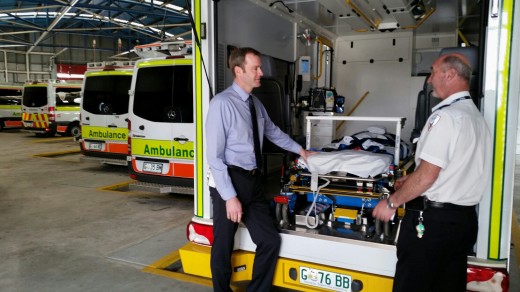
At the Ambulance Tasmania station in Launceston today (Sep 12) with duty manager Greg Edsall looking at a special operations ambulance
Earlier this week during the Estimates sessions in Hobart I explained the ramping issue to a Legislative Council committee. Newspaper photos of ambulances may lead some people to believe that patients are waiting inside the vehicles – they’re not. Below is an extract from the Hansard record where I explain ramping.
Ramping is not new. Ramping is a long standing problem that this government inherited from the previous government. It has not been addressed. At different times, seasonal times, the ramping issue has been more of an issue and at other times less of an issue.
Unfortunately there is a misunderstanding in the wider community about what ramping is and what causes it. I do not want to be too detailed in giving a story here but the truth is that ramping is not where people are waiting in an ambulance on an ambulance ramp, which is what some people do think when they see a line of ambulances in a photograph; they may be forgiven for thinking that the patients are in there with the ambulance paramedics, they are not.
I am sure that we realise that they will be inside the hospital itself, accompanied by their paramedic team, in the care of their paramedic team, but they have not been fully handed over as a patient to the THO or the emergency department and they are waiting in line.
Another misunderstanding in the community is that somehow it is a reflection on the performance of the emergency department, which, by and large, it is not. It is a reflection of the patient flow.
It is a reflection of the stop-start nature and the blockages that sit within a patient flow from the emergency department waiting room through to the emergency department through to hospital wards and then to being discharged. Where that flow is interrupted or blocked in any way, when you then start having ambulances arriving at the ED with patients who need care, you then start to see that ramping.
From the ambulance perspective we call it ramping, in an ambulatory case we refer to it as someone waiting in the waiting room, patiently waiting to be admitted.
It is about patient flow. I wanted to put on record once again that the Government does not dismiss or denigrate in any way the work of the emergency department. We do denigrate ourselves here in that we could have and should have, as a system, managed patient flow much better.
Mr Farrell, you have asked me what the Government is doing about it and you mentioned the Nell Williams Unit, which was a unit that sat inside and alongside the emergency department and was closed by the previous government. It is no longer the Nell Williams Unit as such but the beds are still there and available, and they have not been used.
I have issued a Ministerial Direction to THO South. Among other things, I have directed that they should produce a performance improvement plan which deals not just with opening up more beds but deals with that patient flow issue. That is what we need THO to deal with. To support their efforts, I have also directed that they should reopen those beds and make them available in the best possible way to address what is commonly known as ramping.
I have given THO South some flexibility and some time to come back to me with a coherent plan – not a reaction but a plan that will address patient flow issues. The biggest problem here is that ambulance paramedic staff are accompanying and looking after their patient in the ramping environment and we would rather that they were on the road looking after the other person who is waiting for an ambulance response.

